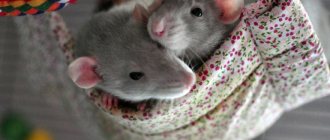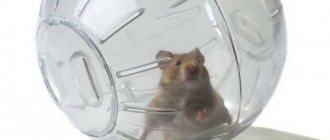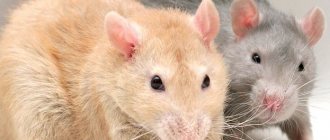Spaying or neutering your pet rat is common practice among dedicated and loving rat owners. On the one hand, the procedure offers many benefits for your pet rat, especially female rats. However, as with most surgical procedures, there are risks that need to be considered before subjecting your beloved pet rat to the stress of surgery and recovery.
Before performing an invasive procedure on your rat, take the time to learn about the pros and cons of neutering rats and how to care for your rat before and after surgery.
Indications
Castration of rats can be carried out to treat or prevent diseases of the reproductive system, correct the behavior of sexually mature animals and prevent the appearance of unwanted offspring.
Medical indications
One of the main reasons for removing reproductive organs in rats is for medical reasons. This is due to the fact that rats are susceptible to cancer. Among the diseases diagnosed in adulthood, the most common neoplasms in females are neoplasms of the mammary glands (MGN), uterus and ovaries, and in males - malignant tumors of the testes.
Increased susceptibility to diseases of the reproductive system is one of the arguments for using castration of rats as the most effective way to prevent oncology. Performing the operation at a young age will allow the rat to recover much faster and minimize the likelihood of developing many dangerous pathologies of the reproductive organs in the future. Neutering female rats significantly reduces the risk of developing pituitary tumors.
Clear indications for the procedure are diagnosing diseases in rats that can only be treated by surgical removal of the testes and appendages (with or without the uterus).
Hyperaggression of males
Rats tend to form family or territorial groups, so keeping solitary animals is considered unnatural for these rodents. The coexistence of several animals is associated with problems of a different kind: after puberty, conflicts arise between same-sex rats (mainly males), which often result in serious injuries. Often in sexually mature males, hyperaggression also occurs towards the owner.
Castration of rats makes it possible to correct their behavior. Castrated males can coexist quite peacefully in the same cage.
Keeping different-sex individuals
When listing the main reasons for castration of rats, we should specifically focus on the high fertility of these rodents. Pregnancy in a rat lasts only three weeks, and each litter can have from 5 to 20 cubs (depending on the species). Almost immediately after giving birth, the female is ready for mating again. Unlike their outdoor relatives, ornamental rodents are ready to reproduce throughout the year.
Uncontrolled reproduction has an adverse effect on the condition of the rat: frequent childbirth depletes its body, significantly shortening its lifespan. Another problem arises related to the need to accommodate numerous offspring.
If you plan to keep rats of different sexes, the best solution would be to pre-castrate the males or sterilize the females. Castrated males can be kept together with females without the risk of having numerous offspring.
Should male pet rats be neutered?
Some rat owners decide to have their male rats neutered. There are several good reasons why you might want to spay your male rat.
The first reason is the male’s excessive aggression towards other rats. If your male rats are too aggressive towards each other, you may want to consider neutering them. However, take a few things into account.
If you neuter one male rat, you must neuter all of them. After all, if you castrate only one male rat, the lack of testosterone may cause other male rats to think that the spayed rat is a female. So make your decision based on whether to neuter all of your rats, not just one.
One more thing to consider. Rare fights between males are normal. Many rat owners have the philosophy that if there is no blood, then everything is fine when it comes to their fights. But if your rats seriously look like they have problems with each other - constant aggressive behavior, frequent fighting, bloodletting - then you may want to consider neutering them.
If your rats really have a problem with each other, things can get dangerous and one can kill the other. However, keep in mind that this is very rare, and it is much more likely that your rats are just playing fighting.
Another reason for spaying and neutering is that owners want to keep male and female rats together. Most rat owners will only have boy rats or just girl rats. If they have both, they will always keep them separate. Or, if they let them stay together, they'll be prepared to have a ton of new rat babies.
But if you want to keep male and female rats together and don't want to raise baby rats, you really need to spay the male rats and neuter the female rats. Otherwise you will soon have a lot of baby rats.
Contraindications
Castration of rats is associated with certain risks for the animal. It is not recommended to perform the procedure on individuals older than 1 year, since the body’s response to anesthesia worsens with age. Limitations include some comorbidities. A ratologist, a veterinary specialist who treats rodents, will help eliminate possible contraindications. You can make a decision to castrate a rat after a preliminary examination by a specialist.
An operation in the presence of contraindications is possible when the obvious risks from the identified disease exceed the risk of possible complications during the intervention.
Operate at home or in a clinic?
The procedure for castrating a cat can be successfully carried out both in a veterinary clinic and at home. The doctor's algorithm remains the same. However, there are significant disadvantages to working outside a hospital setting. For example, it is impossible to quickly help a patient with a mustache if complications arise. On the other hand, in a familiar room your pet will not develop stress reactions.
How does castration of a cat take place in the clinic? There are more positive aspects here. For example, there is less chance of catching an infection, and it is possible to provide quick help in case of complications. In addition, the cost of the procedure will be lower, because calling a doctor to your home will cost more.
Optimal age
There is no consensus regarding the timing of castration. Most veterinarians believe that the optimal age for a rat is 3 to 4 months. By this point, all organs of the genitourinary system have already been formed, and the growth and development of the rodent has stopped. At the same time, at this age the rat is still young enough to tolerate anesthesia and surgery well, and also to recover quickly in the postoperative period.
Some experts believe that it is possible to operate on a rat almost immediately after puberty, which usually occurs by 40-50 days of life. A specialist will help you correctly determine the recommended age for castration of a particular individual after examining the rodent.
Why is surgery needed?
Castration and sterilization are the main method of preventing unwanted reproduction of domestic animals. Essentially, this is a surgical procedure during which the reproductive organs of the animal being operated on are removed.
In addition to protecting against uncontrolled reproduction, the operation corrects the behavior of rats (makes aggressive and hot-tempered individuals calmer), and also prevents the occurrence of serious diseases of various types in the animals. However, often the removal of reproductive organs is used not only for preventive purposes, but also during the treatment of already formed diseases that mainly affect the reproductive system.
Points for and against
There are constant discussions around the issue of castration of rats between opponents of the operation and those who consider its implementation necessary and justified. The main argument against sterilization is the rat's short lifespan. Many people believe that an animal that will live only 2-3 years should not be subjected to a rather dangerous operation. In addition, uncontrolled behavior and the appearance of strong-smelling discharge at certain periods are not so pronounced in rats, which reduces the motivation for surgical intervention. Another reason for disapproving of castration of rodents is that they do not tolerate the effects of painkillers. In some cases, animals do not recover from general anesthesia after the procedure is completed. This problem has recently become less acute due to the advent of safer inhalation anesthesia.
Intervention is advocated by many veterinarians, breeders and nursery owners who are constantly faced with the need to treat adult animals for various pathologies. Castration is especially important for females, in whom the production of sex hormones very often causes pituitary tumors and rapidly growing neoplasms of the mammary glands. Neutering rats is also the most effective way to control your pet's reproduction.
Before making a decision, it is necessary not only to weigh all the arguments for and against, but also to evaluate the conditions in which the rat will live: whether it will be kept alone or in a group, with individuals of what sex it will be in the same cage, etc.
pros
The positive consequences of castrating a rat include reducing the risk of developing dangerous pathologies and increasing its life expectancy. After the procedure, it is possible for both same-sex and opposite-sex individuals to live together without negative consequences.
Minuses
Removal of the reproductive organs does not have the same effect on the rat as on other animals. Many owners are interested in the question: does castration lead to obesity, and will the pet become less active? Removing the testes or ovaries will not cause weight gain or cause drastic changes in behavior other than eliminating episodes of aggression.
The disadvantages of castration are the anesthetic risk and the cost of the intervention, comparable to performing the same manipulations on a cat or dog.
Preoperative preparation for sterilization and castration of rats
If your pet rat is prone to respiratory illness, your veterinarian may prescribe antibiotics for a few days before surgery. This will ensure that the animal is healthy enough to undergo surgery and will reduce the risk of infection after the procedure.
Unlike cats and dogs, your pet rat does not need to fast before surgery. Rats cannot vomit or regurgitate, so there is no risk of accidentally inhaling regurgitated food or stomach acid while under anesthesia.
Fasting can be dangerous because it reduces energy reserves and makes rats more susceptible to dehydration and hypoglycemia. In some cases, fasting can be dangerous because it can alter the rat's response to the anesthetic.
Inhalational anesthetic is safer than injection in rats because the dose is easier to measure. If your veterinarian does not use an inhalational anesthetic, do not proceed with the surgery.
Complexity of the operation
The technique for removing testes or appendages in a rat is similar to performing the same procedure on other animals. The differences relate to certain surgical nuances: the doctor must know the characteristics of the rodent body and have experience in performing operations with small surgical access and the need to suture thin tissues of internal organs.
The difficulty of castration also lies in the fact that due to the small weight of rats, it is difficult to select the dose of anesthesia, and many drugs intended for intravenous administration are not recommended for use at all.
Pros of cat “sterilization” (castration)
Benefits of sterilizing cats:
- Preventing unwanted pregnancy in cats.
- Stopping unwanted behavior associated with your cat's heat.
- Preventing mammary tumors, a very common and serious problem in older animals. Castration before the first heat reduces the risk of hormone-dependent mammary tumors by 98%, castration before the second heat reduces the risk of hormone-dependent mammary tumors by 80%. Castration after the second heat does not have any effect on the risk of developing tumors.
- Completely eliminates the possibility of developing such common and dangerous diseases as pyometra (purulent inflammation of the uterus), endometritis, and polycystic ovary syndrome.
- Eliminates the risk of sexually transmitted diseases.
It is important to remember that a cat can become pregnant before the age of one year, including from cats from the same litter. For animals there is no pronounced social prohibition, as there is for people, which sometimes leads to incidents - the owners are sure that keeping an unsterilized (fertile, that is, capable of reproducing) cat and her son or brother together is quite safe, because “they are relatives”
But such ideas are alien to cats, and pregnancy in such conditions is quite likely.
It is a common belief that after sterilization the cat will become fat and lethargic and sleep all the time. This myth is based on the fact that after sterilization, cats have a slightly reduced need for caloric intake, and if they are fed the same amount of the same food, this can actually lead to obesity. And being overweight in itself affects a decrease in activity and changes in character. Avoiding this is quite simple - after sterilization, you can choose a special diet for such cats, which will prevent them from gaining excess weight. The level of reduction in calorie needs will vary quite a lot depending on the individual cat, so the decision must be made individually - monitor the condition and immediately switch to a lower-calorie diet when gaining weight
If your cat has already gained excess weight, it is very important to get it into ideal shape. Most likely, she will surprise you after this by returning to active and playful behavior.
When considering the issue of sterilization, one cannot help but touch upon the risk of developing urolithiasis in a pet. A cat is an animal prone to developing pathologies of the urinary system. Probably the main cause of such problems is the increased concentrating ability of the kidneys. Evolutionarily, this feature was fixed as an adaptation to the hot climate in which these animals originally lived. They obtained most of their water from mining. In an apartment where the cat is very limited in mobility, this has become a problem - this feature of the kidneys can affect the disturbance of the sense of thirst, and the cat simply does not want to drink, although the urine is already of very high density. This problem can be prevented by introducing wet food into the diet or completely switching to a wet diet (or to a balanced homemade diet - unbalanced food can also lead to the development of KSD). To check whether your cat is drinking enough, it is best to take a clinical urine test and evaluate the density of the urine. If it is normal, there is no loss of urinary stone crystals - there is no need to take measures. If urine density is increased, you can try to increase water consumption. Water should be fresh and freely available; it is recommended to place several different bowls of water in the house, not far from places where the cat likes to spend time or sleep. You can try using drinking fountains that simulate running water - however, this is not suitable for all cats, some may simply not pay attention to such an innovation, and for some cats the sound of running water can cause stress (this is quite rare, but be aware of this possibility desirable). You can also try using different bowl materials - some cats prefer to drink only from ceramic or, conversely, only from metal bowls. Usually a small diameter is recommended (such that the cat can touch the edges with its whiskers), but this is also not suitable for everyone - some prefer, on the contrary, wide bowls
You can use flavoring additives (milk, broth in small quantities); it is important to change this water frequently. Also, some cats prefer bottled or distilled water.
Anesthesia
Castration of rats is almost always carried out under general anesthesia. The use of local anesthesia is recommended only in cases where general anesthesia is contraindicated due to the health of the rat. Care after surgery largely depends on the type of anesthesia.
Injectable
This method involves intramuscular administration of the drug. The injection method is considered the most dangerous for two reasons:
- due to the impossibility of monitoring the animal’s condition and adjusting the depth of anesthesia after administration of the drug;
- due to the high toxicity of most painkillers.
At the same time, there is an opinion that intramuscular anesthesia, which lasts for several hours after surgery, reduces the pain of the rat and alleviates its postoperative condition.
Inhalation anesthesia
The supply of anesthetic in the form of gas through a mask makes it possible to minimize all possible risks and negative consequences of anesthesia. The amount of the drug entering the lungs can be controlled, and there is no negative effect on the liver and other internal organs.
Inhalation anesthesia is a more expensive method of pain relief, as it requires special equipment and expensive drugs.
To the tail vein
During the operation, anesthesia can also be given to the rat through the tail vein. This method is the most optimal in terms of cost and safety for the animal.
Common misconceptions of owners
In addition to the confusion of basic concepts, some owners have many misconceptions regarding the removal of reproductive organs. These include the following myths:
- High probability of urinary incontinence in operated animals. Such a risk really exists, but it is only 5%. All other cases are explained by excess weight, old age and breed characteristics.
- The lack of mating makes the operation pointless. Regular empty estrus leads to serious hormonal imbalances, provoking the development of cancer.
- Every female representative is obliged to give birth. Bearing and feeding offspring puts a tremendous strain on the body, and the joy of motherhood is not typical for animals.
- Obesity after surgery is inevitable. Despite the appearance of a tendency to be overweight, weight can be easily controlled if the recommended caloric intake is observed.
- Contraceptives are the safest method for preventing unwanted pregnancy. Systematic interference with hormonal levels is fraught with serious complications.
- Artificial infertility reduces life expectancy. Thanks to protection from diseases of the reproductive system, neutered pets live longer than non-neutered ones.
- The actions of even the most experienced surgeon will certainly lead to the formation of a large scar. Dog skin regenerates quickly, so all marks disappear within a few months. If aesthetics are important to you in the near future, give preference to laparoscopy. This method eliminates the classic incision and is based on tiny punctures of 5-10 mm.
The only justifiable fear is the risks associated with anesthesia. For the safety of your pet, you should choose an experienced surgeon and a trustworthy clinic.
If your friends and acquaintances still don’t know whether dogs go into heat after sterilization, be sure to share new information with them and try to dispel any misconceptions they have. Remember that the safest and most reliable way to get rid of menstruation is castration. Cases of resumption of estrus after such an operation are minimal and are most often associated with medical negligence.
The article is for informational purposes only. Contact your veterinarian!
Postoperative period
The doctor who will castrate the rat will tell you in detail about how long the rehabilitation period lasts and how to care for a castrated rodent. Typically, care after castration includes monitoring the animal's condition and proper feeding.
Recovery from anesthesia
The greatest attention after the end of the procedure requires the animal to recover from anesthesia. If necessary, the rat should be placed on a heating pad and covered to maintain body temperature. The animal should be placed on its side to prevent the tongue from sinking. The litter must be clean and must be changed as soon as it gets dirty.
How long it takes for a rat to recover from anesthesia depends on the type of anesthesia and the state of the body. After inhalation anesthesia, the rodent comes to its senses within 10-20 minutes. When using injection anesthesia, recovery from anesthesia may take several hours. During this period, it is necessary to ensure constant supervision of the pet.
Feeding
You can feed the rat immediately after regaining coordination of movements. On the first day, it is necessary to limit the amount of food to ½ the daily ration. In the absence of complications, nutrition in the following days is carried out as usual.
For 2-3 days, you should constantly keep an eye on the rat: inspect the sutures, monitor appetite, diuresis and defecation.
Postoperative care of rats
If no complications arise, the rat should be sent home the same day. This will reduce stress levels and make the recovery process easier for your pet rat. A reputable veterinarian will show you what the incision looks like and note any warning signs.
While the rat is recovering, it should be kept in a small cage separate from other rats for at least one full day. A cat carrier works well for this purpose as it is more confined and limits unnecessary movement.
It is important to keep the rat warm during and after surgery because the anesthetic interferes with body temperature regulation. You can keep your rat warm by using a covered heating pad, but you will need to be careful that the rat does not overheat and try to chew it.
Your veterinarian may prescribe antibiotics and pain relievers to reduce the risk of infection and help your rat feel more comfortable. It is important to follow the instructions carefully and complete the full course of antibiotic treatment unless otherwise directed.
Check the incision regularly for signs of infection such as redness, pus, and swelling.
After 24 hours, the neutered female rats can be reintroduced to their cage mates, but you must ensure that no one tries to disturb the incision. After 7-10 days, your female rat should be well enough to run, climb, and play with her cage mates.
Male rats may take up to 3 weeks to fully recover. It may take 6 to 8 weeks for aggressive behavior to change.
Complications
Castration of rats is associated with the risk of developing surgical and postoperative complications. Incorrect calculation of the dose of anesthetic can cause death or disruption of the functioning of internal organs, primarily the kidneys.
Complications after castration of rats can be caused by wound infection or self-removal of sutures. The penetration of infection is indicated by redness and swelling of the skin around the incision, and the appearance of purulent discharge. In case of any deviations from the normal state, it is necessary to show the rat to a veterinarian as soon as possible.
Complications after spaying and castrating rats
In addition to signs of infection, you need to check your rat for the following complications:
- Sudden bleeding.
- Reopening the incision site.
- Abnormal breathing.
- Excessive lethargy.
- Lack of appetite, thirst.
- Postoperative abscesses.
Complications resulting from spaying or neutering can range from mild (minor infection) to severe (respiratory or heart failure). Therefore, it is extremely important to keep a close eye on your pet rat and seek immediate veterinary help if necessary.
To avoid complications, follow these recommendations:
- Make sure your veterinarian is experienced in spaying and neutering rats.
- Ask all important questions in advance.
- Avoid surgery if the risks outweigh the benefits (older age, prone to infections, etc.)
- Check the rat for complications.
Estrus, pregnancy and childbirth
Not all owners understand the relationship between the reproductive and reproductive systems. Because of this, it is completely unclear when to spay a cat: before, during or after heat. Even more difficulties arise with the need for childbirth. Many owners mistakenly believe that deprivation of reproductive function is safe only after bearing at least one litter.
Surgery during pregnancy
Surgery is permissible if the pregnancy is no more than 1 month. Otherwise, there is a possibility of increased blood loss and a prolonged postoperative period. Intervention is also permissible in case of abnormal fetal development, poor health or old age, which prevents the safe bearing of kittens. In all other cases, the operation is postponed until complete postpartum recovery.
Surgery after childbirth
After giving birth, a young mother needs 2-3 months to fully recover. During this time, the uterus returns to its original size, and blood circulation in the pelvis is normalized.
Emergency intervention immediately after the birth of kittens is practiced when:
- detection of tumors in the reproductive organs;
- the presence and high probability of postpartum hemorrhage;
- uterine rupture;
- damage or abnormalities of the placenta.
In these situations, the risk of possible complications is higher than the risks associated with sterilization. The procedure is considered justified.
Is it necessary for a cat to give birth at least once before sterilization?
The most popular question arising from the baseless myth about the “joy of motherhood.” From a psychological point of view, animals are not subject to emotions and act instinctively. The absence or presence of pregnancy is taken for granted by them, and therefore does not have a fundamental impact on their lives.
An obvious logic appears when considering the issue from a biological point of view. Before pregnancy, female sex hormones (estrogens), responsible for sexual desire, are produced by the ovaries. If they are removed in a timely manner, the animal loses not only the ability to conceive, but also interest in the opposite sex. Otherwise, other internal secretion organs are involved in the production of estrogen. As a result, the operated pet will not be able to become pregnant again, but will continue its loud rituals of calling cats. If you do not want to endure such concerts for the rest of your furry pet’s life, do not allow mating until sterilization.
In addition to the high risk of retaining some sex hormones, pregnancy reduces the effect of the procedure. The probability of developing cancer after the first birth is 8%, and after the second it increases by more than 3 times.
Is it possible to operate on a cat during heat?
During estrus, hormonal changes occur. Any intervention is fraught with multiple complications, including the development of oncology. Due to the dilation of blood vessels, there is a high probability of heavy blood loss. Animals recover from anesthesia worse and have a more difficult time experiencing the postoperative period.
It is safer to carry out surgery 2 weeks before or after estrus, when the pet’s condition returns to normal. Exceptions include prolonged heats with a short interval between them. They impair quality of life and lead to exhaustion. In this case, the animal is sterilized for medicinal purposes.
Surgical methods of castration of cats:
- palliative – ligation of spermatic cords (sterilization) of cats,
- radical (removal of the gonads) – castration of the cat.
Palliative surgery (sterilization) - ligation of the spermatic cords in cats. It does not reduce the animal's libido and sexual functions, because... The testes and ovaries are preserved during these operations, and the hormonal levels of the animal do not change (i.e., cats still mark and scream during the mating season). This type of operation is chosen very rarely; it can be preferred if the owner has both male and female cats, but does not want to breed kittens.
A radical method - castration of a cat - a surgical operation to remove the testes, which, along with stopping bleeding, delivery, and tracheal intubation, is mandatory for any certified veterinarian.
Castration of a cat is done in two ways:
Open method. This surgical intervention is as follows. Under general anesthesia, the skin of the scrotum is incised and the tunica vaginalis of the testicle is opened. By pressing, the testis is squeezed out. Separate the vas deferens from the vessels and tie them together into a knot. These manipulations are performed from the other side. After which the testes are removed, and the spermatic cords are removed into the vaginal membrane. If the operation is performed correctly, there are no stitches!
Closed method. Performed without opening the tunica vaginalis of the testicle. The testis along with the vaginal membrane is removed from the scrotum along with the spermatic cord. The spermatic cord together with the vaginal membrane is ligated and dissected, and, if necessary, a hemostatic clamp is applied. The same manipulation is carried out with the other testis. The scrotal skin is not sutured.
The duration of surgery in both ways is about 5 minutes.
There are no contraindications for castration. In cases where there are contraindications to general anesthesia, the operation can be performed under local anesthesia.
Preoperative preparation. Castration is a planned operation, therefore, at the time of the operation it is necessary to prepare the cat: - monitor its condition (temperature, appetite, activity, condition of stool and urination),
- the animal must be healthy;
- pre-deworm the animal;
- the day before, wash the cat with zoohygienic shampoo (Shampoos);
- do not feed the animal for 10–12 hours before surgery (to avoid vomiting);
- Do not give water for 4 to 6 hours before surgery.
The postoperative period usually goes smoothly. No special care for the animal is required. After the cat comes out of anesthesia, you need to keep an eye on him for 24 hours. It is advisable to limit the activity and mobility of the animal. After the final awakening (after 3-4 hours), you can offer him water. It is necessary to ensure that the animal does not lick the wound. Provide him with a clean litter box and keep it free of litter for several days.
In case of lethargy, apathy of the animal for several days, or lack of appetite, it is recommended to consult a doctor. To avoid stress, it is better to carry out surgery at home, in a familiar environment for the animal, where, after recovery from anesthesia, it will be among close people.
Complications, as a rule, are not observed, but bleeding and swelling of the scrotum are possible.
Sterilizing rats has a number of positive aspects
- Unspayed females have a 75% chance of developing one or more mammary tumors. These tumors can grow to enormous sizes in a short period of time. Removing the ovaries virtually eliminates the possibility of this type of cancer developing in rats.
- Neutering female rats reduces the likelihood of pituitary tumors, which are also common in rats. Pituitary tumors are brain tumors. They cause loss of coordination and inability to eat. Ultimately, such tumors lead to the death of the rat. Diagnosis and treatment of such tumors are very difficult and expensive.
- Sterilization of rats completely eliminates future diseases of the ovaries and uterus.
- Neutered rats can be kept with male rats. There is no risk of the rat becoming pregnant.










